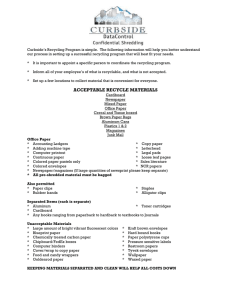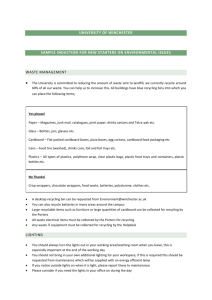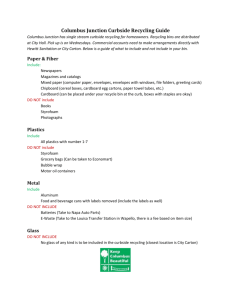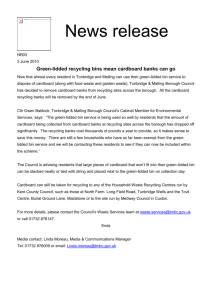Introduction - Aceti Associates
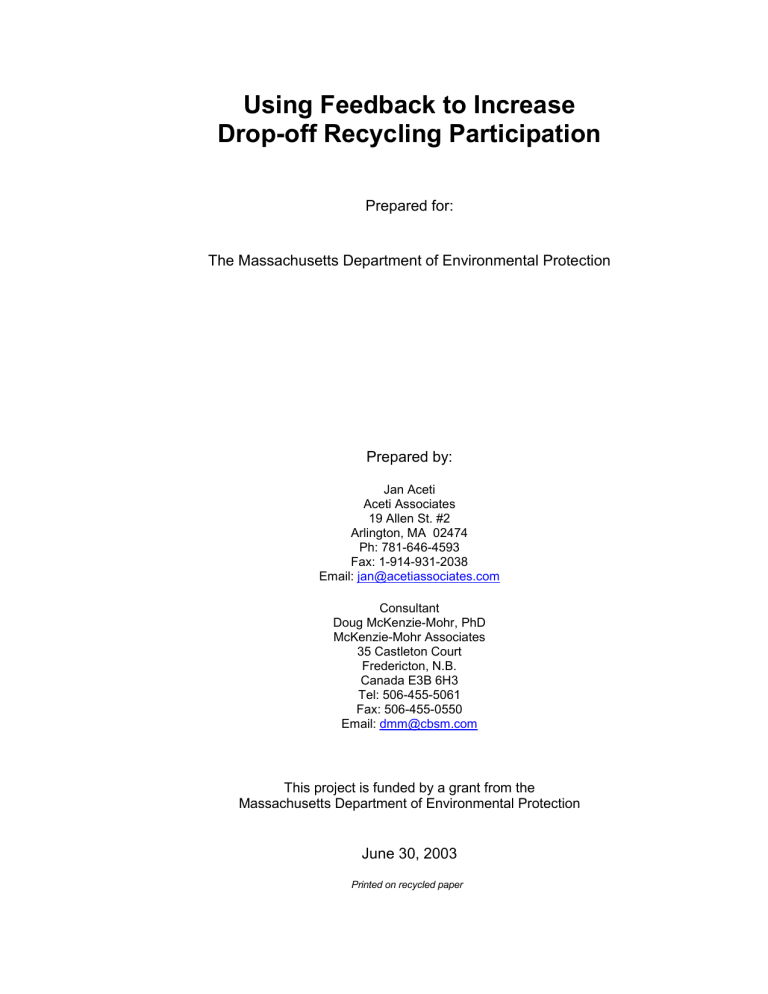
Using Feedback to Increase
Drop-off Recycling Participation
Prepared for:
The Massachusetts Department of Environmental Protection
Prepared by:
Jan Aceti
Aceti Associates
19 Allen St. #2
Arlington, MA 02474
Ph: 781-646-4593
Fax: 1-914-931-2038
Email: jan@acetiassociates.com
Consultant
Doug McKenzie-Mohr, PhD
McKenzie-Mohr Associates
35 Castleton Court
Fredericton, N.B.
Canada E3B 6H3
Tel: 506-455-5061
Fax: 506-455-0550
Email: dmm@cbsm.com
This project is funded by a grant from the
Massachusetts Department of Environmental Protection
June 30, 2003
Printed on recycled paper
Table of Contents
Introduction
The Motivation: Social Pressure
The Mankato State University Strategy
Test and Control Communities
The Dover Strategy
Pilot Implementation
Results
Lessons Learned
Appendix A: Options for Setting Up Test and Control Conditions
3
3
3
3
5
8
9
10
12
Acknowledgements: The project sponsor and staff gratefully acknowledge the Towns of Dover and Carlisle for their willingness to take part in this project. Furthermore, Dover Recycling
Committee Chair Ilene Mason, Highway Department Director Craig Hughes, Director of Office
Administration Nancy Hughes and Transfer Station Operator Wade Hayes were involved in project planning, implementation and tonnage monitoring. Gary Davis, Superintendent of Public Works for the Town of Carlisle, provided tonnage data and synchronized Carlisle’s cardboard pick ups with
Dover’s when needed.
2
Introduction
In 2003, the Department of Environmental Protection funded a pilot project to test the potential of a community-based social marketing (CBSM) strategy for increasing drop-off recycling participation. CBSM uses social science knowledge regarding behavior change to encourage environmentally sustainable practices. CBSM involves 1) identifying the barriers and motivations associated with participation in an activity; 2) designing a strategy to overcome the barriers and strengthen the motivations using proven behavior change tools; 3) piloting the strategy on a small scale to assess its effectiveness.
1
The Motivation: Social Pressure
Social scientists have been studying recycling behavior since the 1970’s. In order to identify the barriers and motivations that are related to people’s recycling habits, social scientists ask recyclers and non-recyclers questions about a wide variety of factors that might influence their recycling behavior. They then use statistical methods to determine which of these factors are linked to recycling participation and which are not.
2 Reviewing the social science literature reveals that “social pressure” shows up in numerous studies as being linked to recycling habits.
People are motivated to recycle by actual pressure they receive from family and friends to do so.
Furthermore, simply knowing that family, friends and neighbors recycle increases our likelihood of recycling.
3
The Mankato State University Strategy
Providing feedback on recycling rates gives individuals clearer information about the extent to which others are participating in recycling. In the early 1990s, researchers at Mankato State
University in Minnesota tested this strategy by placing signs above aluminum can receptacles in academic buildings. The number of cans deposited in each receptacle was counted on a daily basis, and each week, a sign was posted on the wall behind the receptacle reading, “Last week
____ cans were recycled in this container.” This message was posted on a 10” x 13” sign that consisted of a 2” black border surrounding an 8” x 11” sheet of paper. The posting of the signs resulted in a 65% increase in the number of aluminum cans deposited, compared to receptacles where no signs were posted.
4
This strategy was piloted in Massachusetts in 2003 to determine if it would motivate municipal recycling drop-off center users to recycle more material.
Test and Control Communities
During the Massachusetts pilot project, changes in recyclables tonnage were monitored not only in the community where the feedback signs were being tested (the “test community”), but also in a “control community,” – a similar community in which no outreach was done. Monitoring the tonnage in a control community provided information about changes in recycling tonnage that occurred due to factors other than the strategy being piloted. These factors might include seasonal fluctuations in recyclables tonnage, or fluctuations due to changes in the economy. In evaluating the effectiveness of the feedback strategy, it was important to subtract out any
1 McKenzie-Mohr, D. & Smith, W. (1999). Fostering Sustainable Behavior: An Introduction to Community-
Based Social Marketing. British Columbia: New Society Publishers.
2 Aceti, J. (2002) The Feedback Sign Strategy. [Fact sheet prepared for the Massachusetts Department of
Environmental Protection] Boston, MA.
3 Aceti, J. (2002) The Feedback Sign Strategy. [Fact sheet prepared for the Massachusetts Department of
Environmental Protection] Boston, MA.
4 Larson, M.E., Houlihan, D. & Goernert, P.N. (1995). Brief Report: Effects of Informational Feedback on
Aluminum Can Recycling. Behavioral Interventions , 10(2) 111-117.
3
change observed in the tonnage collected in the control community, since it would be due to factors other than the strategy.
Several schemes were considered for monitoring changes in recycling tonnage due to factors other than the strategy. Using a test community and a control community was judged to be the best method. A detailed explanation of the other options can be found in Appendix A.
In order to be selected as the test community, municipalities needed to meet the following criteria:
Interest in increasing their recycling rate;
Ability to identify a recyclable material accepted at their drop-off center for which there was room for improvement in the recycling rate and for which the weight recycled could be obtained at least weekly. Weekly weights would allow new feedback to be provided frequently.
Willingness to devote some staff time to the project and to produce and install the feedback signs; and
A drop-off center layout that allowed for good sign visibility.
In order to be selected as the control community, municipalities needed to meet the following criteria:
Willingness to provide project staff with load weights for the material of interest within several days of a pickup.
Willingness to modify pick up days for the material of interest so that the pick up days matched those in the test community at the beginning of the “baseline” period and at the beginning and end of the feedback period. Baseline weights for the material of interest were monitored in the test and control communities before the feedback signs were introduced in the test community. Weights for this same material were also monitored in both communities during the feedback period, that is, the period during which the feedback was provided in the test community.
In order to be selected as the test or control community, municipalities needed to meet the following additional criteria:
Recycling program stability. That is, the community could not be planning changes to its recycling/solid waste program during the pilot project period that had the potential to affect recyclables tonnages. These changes might include introduction of a pay-as-you-throw
(PAYT) program, or a reduction in the number of weekly open hours at the drop-off center.
An average recycling rate. Communities with very high recycling rates were not selected because of the possibility that the high levels of recycling already achieved would impose a ceiling on further improvement.
Non pay-as-you-throw community. PAYT programs generally increase recycling rates dramatically. Therefore, communities with PAYT programs were not considered because of the possibility that the high levels of recycling already achieved would impose a ceiling on further improvement.
Recycling Rate Stability. Communities whose recycling rates appeared to be changing significantly over time from 1998 to 2002 were not selected. This criteria helped to guard against the possibility that community-specific factors other than the strategy might cause changes in recyclables tonnage.
Population stability. Population shifts could cause changes in recyclables tonnage during the pilot period. Therefore, communities experiencing rapid annual population growth or population influxes during the summer vacation season were not selected.
Good record keeping practices.
Location in the eastern part of the state. Since the budget for the pilot project was limited, the communities were chosen so as to avoid excessive travel time for the project staff.
4
In order to be selected as the test community/control community pair, the two communities needed to have the following characteristics in common:
Demographic similarity in terms of median income and education levels
The material of interest was kept in a container separate from other materials.
Of the twelve non-PAYT communities that were originally considered for the pilot, the towns of
Dover and Carlisle were judged to best meet the multiple criteria listed above. Cardboard was chosen as the material for which to provide the feedback. Table 1 lists some characteristics of the two communities.
Table 1. Test and Control Community Characteristics
Criteria Test Community
Dover
Community Recycling Rate [1] 1998
1999
2000
2001
2002
17.5%
19.5%
18.5%
19.4%
19.4%
Control Community
Carlisle
1998 26%
1999 25.4%
2000 25.9%
2001 28.4%
2002 27.9%
Median Income
% with College Degree
$141,818
82.2%
$129,811
86.6%
[1] This recycling rate is for paper and bottles and cans only. The trash tonnages used in the calculations didn’t include bulky waste, as this material was not consistently reported for the Town of Carlisle.
Identifying two communities that met all of the necessary criteria was challenging. No two communities emerged as an ideal choice from among those considered. Although Dover and
Carlisle were the best choices, two drawbacks to this selection were recognizable from the outset.
Dover and Carlisle are two of the most affluent communities in Massachusetts, and therefore aren't representative of the state as a whole. Whatever the results of the pilot, concluding that the same results would be obtained in more typical Massachusetts communities might not be justified. Secondly, there was a difference in how the two communities store their cardboard between pick ups. The Town of Dover stores its cardboard in an open topped roll-off container that is covered by a weather-proof tarp when the drop-off center is closed. When the drop-off center is open, the tarp is partially removed in order to provide residents access to the container. Thus, cardboard in the uncovered section is exposed to the rain if there is precipitation during drop-off center open hours. The Town of Carlisle stores its cardboard in a closed compactor box, which protects the cardboard from exposure to the elements virtually
100% of the time. Because cardboard absorbs water, the possibility existed that wet weather could affect the weight of the cardboard collected in Dover during the pilot, without a similar effect in Carlisle. Furthermore, differing amounts of precipitation might affect cardboard weights differently during the baseline and feedback periods in Dover. Despite the drawbacks discussed here, Dover and Carlisle best met the necessary criteria among non-PAYT communities in the eastern part of the state.
The Dover Strategy
The Signs
Three identical feedback signs were placed at Dover’s transfer station/recycling drop-off center.
One sign was placed in front of the cardboard roll-off container. A second was placed in front of the transfer station operator’s booth, where signs notifying users of holiday closures were regularly placed. Transfer station users also drove by this sign on their way to the trash compactors. A third sign was placed near the transfer station exit. Figure 1 displays the sign text and design. Figure 2 shows the sign locations.
5
Figure 1. Sign Text and Design
Figure 2. Sign Locations
In front of the cardboard roll-off container
6
In front of the transfer station operator’s booth
Near the transfer station exit
Each sign was 4 ft x 3 ft and was attached to a Plasticade stand that supported it. The signs were made from traffic sign material with Prismatic letters by Perma-Line Corp. of New England
(Ph: 508-587-2110). The feedback was written with a marker on a translucent rectangle of
Plexi-Plastic that was attached to the front of each sign. It was erased with ZEP ERASE Vandal
Mark Remover, a graffitti removal product, to allow the new figure to be written in each week.
The Feedback
Dover’s transfer station is open from 8:30am to 3:30pm on Wednesdays, Saturdays and
Sundays each week. Most users visit the transfer station on Saturdays and Sundays. The cardboard roll-off container is generally emptied once or twice during the week, with one of the pickups always occurring on Thursday or Friday. The feedback on the signs was changed each
Friday. The weight of the cardboard that had been collected since the previous Friday was converted into its equivalent in terms of medium-sized boxes. This figure was calculated by
7
converting the tonnage collected during the week to pounds and then dividing by 1.33 lbs, the weight of a medium-sized box of dimensions 1 ft x 1 ft x 1.5 ft. Prior to the pilot, Dover collected about 1.5 tons of cardboard per week on average, corresponding to about 2,300 medium sized boxes. The number of boxes was written on the translucent panel in the middle of the sign with a marker.
Pilot Implementation
Providing the Feedback
Dover DPW staff calculated the number of boxes corresponding to the cardboard tonnage each week. A member of the staff then went to the transfer station each Friday and changed the feedback on the signs.
Protecting the Cardboard from the Weather
Project staff conferred with the transfer station staff about protecting the cardboard from the weather as much as possible during open hours, but there was no easy way for them to do this and still provide visitors with access to the container.
Monitoring the Tonnage
Both Dover and Carlisle DPW staff faxed cardboard weights to the project staff within several days of each pick up. Before the feedback signs were installed at the Dover transfer station, the cardboard weights for both Dover and Carlisle were monitored for a nine week baseline period, from May 17 – July 18, 2003. Then, while the feedback was being provided to Dover transfer station users, the cardboard weights for Dover and Carlisle were monitored for seven weeks, from July 19 th
– Sept. 5, 2003.
The length of the baseline and feedback periods was originally intended to be a minimum of six weeks each. The length of both periods was adjusted to make it as easy as possible for Carlisle to arrange to have their cardboard picked up on the same day as Dover at the end of each period. Several factors needed to be taken into account in order to synchronize the two communities’ pick up days. First, Carlisle typically had their cardboard picked up every two week s, although occasionally that interval was shortened to one week. Secondly, Carlisle’s transfer station is open on Saturdays, Tuesdays, and Thursdays; Dover’s on Saturdays,
Sundays and Tuesdays. In order to ensure that the data represented an equal number of FULL weeks for each community, it was important that the baseline and feedback measurement periods began and ended on a Friday.
Budget
The monetary costs of implementing the feedback sign strategy in Dover are displayed in Table
2.
Table 2. Budget
Cost
$ 585.00
$ 195.00
$ 780.00
TOTAL
Budget Item
3 Signs @ $195 ea.
3 Stands @$65 ea.
8
Results
The changes that occurred in the test and control community tonnages during the pilot are displayed in Table 3.
Table 3. Pilot Results
Community Avg. Weekly Tonnage % Change in
9 Wk. Baseline Period 7 Wk. FeedbackPeriod Avg. Tonnage
May 17- July 18 July 19 - Sept 5
Carlisle (control) 2.76
2.49
-10%
Dover (test) 2.18
1.31
-40%
The average weekly cardboard tonnage in Carlisle, the control community, declined 10% from the baseline period to the feedback period. This is not surprising. Much of the baseline period occurred during the late spring and early summer, before the ending of the school year. The feedback period occurred primarily during the summer vacation season, when more residents were away.
The average weekly cardboard tonnage in Dover, the test community, also declined, by a dramatic 40%. Clearly, this was not the result that project planners had hoped for. Although
Dover was attempting to increase cardboard recycling with the feedback signs, and although no outreach was done in Carlisle, cardboard tonnage in Dover decreased much more than it did in
Carlisle. If the feedback sign strategy had had an impact on cardboard recycling in Dover, one would have expected the average weekly cardboard tonnage in Dover to decrease less than the tonnage in Carlisle, or even increase. If the feedback sign strategy had simply had no impact on cardboard recycling in Dover, one would have expected the cardboard tonnage in Dover and
Carlisle to decline by a comparable amount, given the similarity of the two communities. The fact that the cardboard tonnage in Dover decreased so much more than the tonnage in Carlisle suggests that factors other than the feedback sign strategy affected the changes observed.
One factor may have been differing vacationing patterns in the two communities. Due to the timing of the grant funding, and the unexpectedly difficult and time consuming process of selecting test and control communities, the feedback period occurred primarily during the summer vacation season. Before the pilot project began, the recycling committee chair and the transfer station attendant both remarked that the population in Dover declines sharply in the summer, due to widespread and extended out-of-town vacation travel. Because household income is likely to be linked to vacationing patterns, it was important to choose a control community that was similarly affluent. Carlisle, with a year 2000 median household income about $12,000 lower than Dover’s was the community most similar in this respect that also met the other necessary criteria to be selected for the pilot. However, it possible that the $12,000 difference in median income is enough to lead to significantly different vacationing patterns in the two communities. It is also possible that median household income is not a complete reflection of the relative levels of affluence in the two communities.
An attempt was made to analyze the extent to which cardboard tonnage had declined in Dover over the same time period in 2000, 2001 and 2002. Unfortunately, some of the data from the month of August in previous years was missing or contained very atypical weights. Also, the intervals between cardboard pickups had been different in previous years, making it impossible to match up the baseline and feedback periods in 2003 with identical periods in previous years.
Consequently, the analysis of 2000-2002 data led to highly inconsistent results that sometimes even showed an increase in cardboard tonnage from the spring to the summer.
9
Another reason why the cardboard weight might have declined so drastically in Dover during the pilot project was the exposure of Dover’s cardboard to the weather during drop-off center open hours. The average weekly rainfall during drop-off center open hours for the baseline and feedback periods was monitored using hourly precipitation data posted by the National Weather
Service at http://www.erh.noaa.gov/er/box/stationobs.shtml
for the Dover area. According to this data, during the baseline period, an average of 0.53 inches of rain fell per week during drop-off center open hours. During the feedback period, the average weekly precipitation was only 0.084 inches during open hours. Indeed, the exceptionally rainy spring and early summer was a common topic of conversation among Boston area residents this year, especially since most of rain seemed to fall on the weekends. Coincidentally, Saturday and Sunday are two of the three days that Dover’s transfer station is open. Because of the rainwater that the cardboard absorbed, higher precipitation levels during the baseline period may have inflated the weight of the cardboard that was collected before the feedback was initiated.
Compared to the 10% decline in cardboard tonnage observed in Carlisle from the baseline period to the feedback period, the much steeper 40% decline observed in Dover may be due to:
more widespread and/or extended out-of-town vacation travel in Dover than in Carlisle during the feedback period;
exposure of the cardboard to the weather in Dover and higher levels of precipitation during the baseline period than in the feedback period; or
both factors.
Dover transfer station users may have recycled more cardboard during the feedback period than they would have if the feedback signs had not been present. However, the magnitude of the cardboard tonnage decline in Dover compared to the decline in Carlisle suggests that even if the signs had a positive impact, it was swamped by the effect of other factors. Consequently, there is no way to know whether or not the signs had a positive impact on cardboard recycling.
Therefore, it is not possible to draw conclusions from the pilot project about the effectiveness of the feedback sign strategy in a drop-off center setting.
Lessons Learned
Although the pilot project did not reveal whether the feedback sign strategy increases recycling in a drop-off center setting, other lessons learned provide valuable guidance for conducting future pilot projects using test and control communities.
1. Population shifts during the summer vacation season may be unpredictable. Pilot projects should not be conducted during this time of the year unless the test and control groups are truly identical. Even in this case it is probably not advisable to carry out feedback strategies during the summer. As July turns into August and more and more people leave town for vacation, the feedback presented appears to be less and less positive in regards to the extent to which others are participating in recycling.
2. No matter what time of year the pilot is to be conducted, it would be worthwhile to look at tonnage data from prior years to try to determine if the seasonal trajectories of the two communities are very different over the period of the planned pilot.
3. Identifying appropriate test and control communities is a time consuming process and should be planned for accordingly. Project staff gathered information from twelve communities and visited six transfer stations before a decision was made.
4.
Identifying potential control communities willing to go to the trouble and expense of participating in the pilot was made more challenging by the fact that the control community gained no immediate benefit by participating. The test community, on the other hand, stood to benefit from a possible increase in their recycling tonnage and from gaining hands-on experience implementing the strategy. In the future, it is recommended that the control community be provided with a small amount of grant money to compensate them for their
10
time and potential expense. If this incentive had been available, it might have been easier to identify a more ideal test community/control community pair.
5.
The possibility that precipitation might affect weight measurements must be avoided.
If the material of interest absorbs water, a municipality must be able to prevent exposure of the material to the weather.
6.
All grant budgets should contain a contingency fund. If funding had been available to offset the cost of building some sort of shelter for the cardboard container in Dover, it would have more appropriate to explore this possibility with the Dover Highway Department staff.
7.
In a strategy that involves feedback signs, such as this one, observations should be conducted throughout the feedback period to determine if people seem to be noticing the signs. Observations conducted towards the end of the feedback period in Dover indicated that when people passed by the signs while in their vehicles (on the way to the trash compactors, and then exiting the transfer station), they did not appear to be paying attention to the signs.
11
Appendix A: Options for Setting Up Test and Control Conditions
Several ideas were considered for setting up test and control conditions.
One idea was to compare the tonnage collected at a drop-off center during the pilot project (the test condition) to the tonnage collected at the same drop-off center during the same months the previous year
(the control condition). However, because the economy had continued to worsen from 2002 to 2003, the economy might have affected recyclables tonnage differently in the test condition and the control condition.
If this were the case, changes observed in the control condition would not accurately reflect non-strategy related changes occurring in the test condition. Therefore, this plan was rejected.
A second idea was to provide feedback on the quantity of one material being recycled at a drop-off center
(e.g. cardboard) (test condition) and compare the tonnage collected to that of another material (e.g. glass) accepted at the same drop-off center but for which no outreach was done (control condition). However, it was possible that feedback pertaining to one material could influence people’s behavior in regards to other materials accepted at the same drop-off center. If so, the control condition could be affected by the strategy, meaning that it would not be a true indicator of changes in recycling tonnage that occurred due to factors other than the strategy. This plan was rejected, too.
A third plan was to conduct the pilot in the Town of Plymouth, which has two drop-off centers. One dropoff center would be used to test the feedback signs, and the other would be used as the control condition.
However, the pilot project time line called for the feedback to be delivered during the summer. Plymouth has a large summer population, which utilizes one drop-off center more than the other. Furthermore, operational changes planned for the pilot project period were expected to affect the number of users at each drop-off center. These differences meant that changes occurring in the control condition would not accurately reflect non-strategy related changes occurring in the test condition. Therefore, this plan was also rejected.
The option that was selected involved choosing two similar communities with drop-off centers for the pilot, one that would serve as the test community and one as the control community. The two communities were required to meet a number of criteria that would help eliminate the possibility that community-specific factors would affect recycling tonnage differently in one community than in the other.
12

